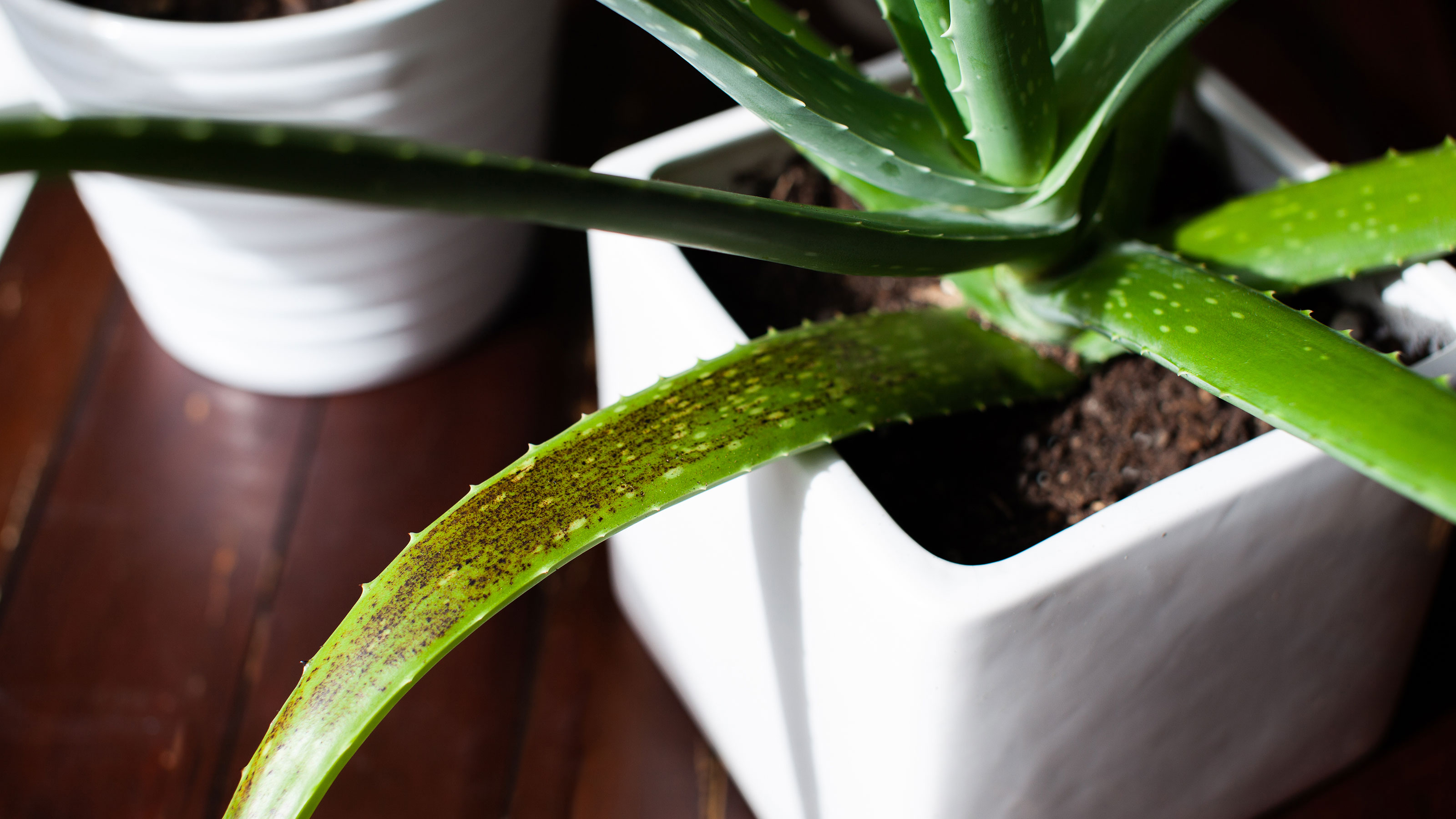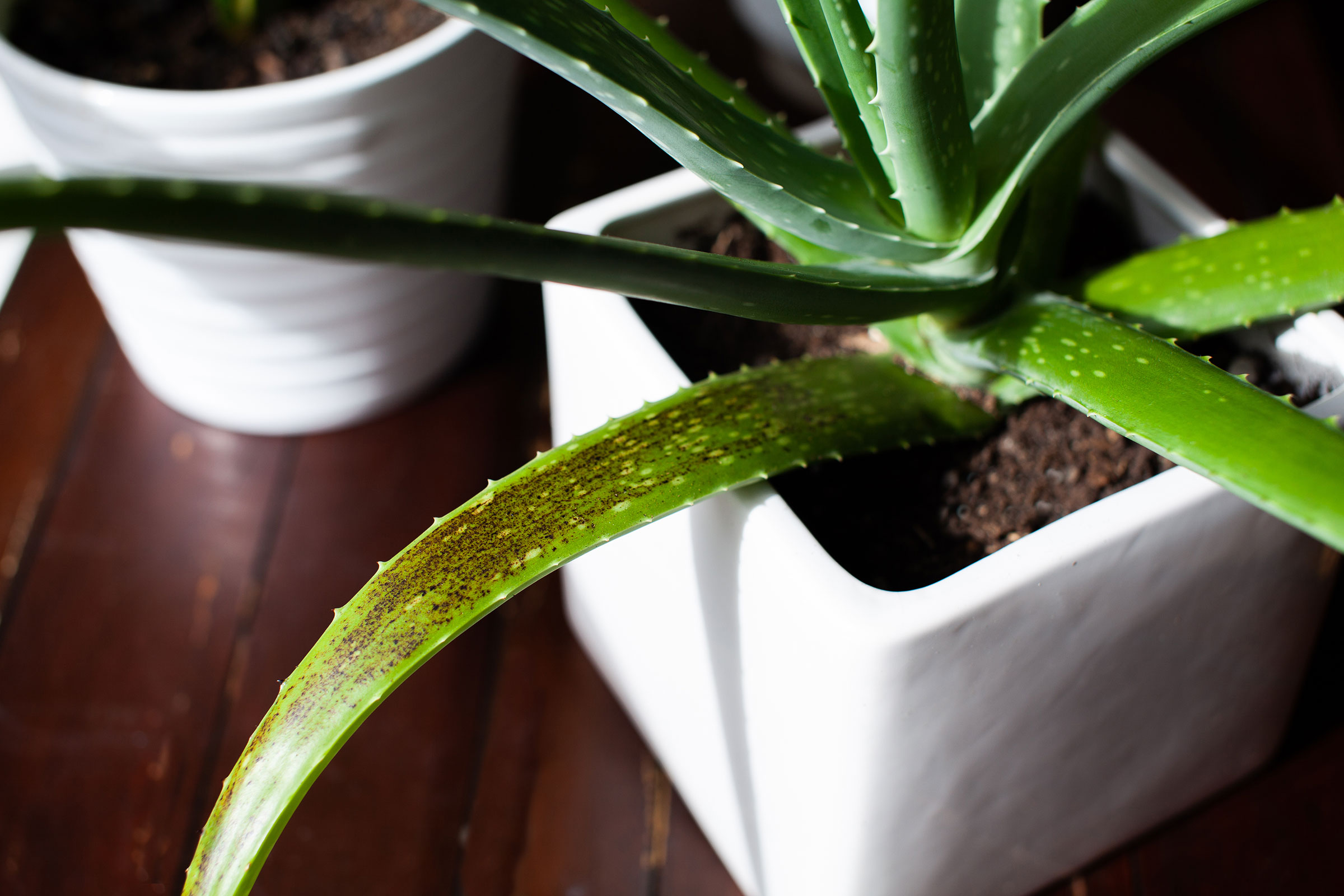Aloe vera plant care problems and how to solve them
It's easy to run into Aloe vera plant care problems. From overwatering to incorrect light levels, this is what to look out for and how to fix unhealthy plants asap.


The perfect houseplant for many, though when you run into Aloe vera plant care problems, you might panic and not know how to get yours back on track. Healthy aloes are a beautiful shade of mid-green with long, sculptural leaves, that not only look good indoors, but also outside too if your climate allows.
Generally aloes are low-maintenance but if you're seeing brown leaf tips, drooping or noticing any other telltale signs of an unhappy plant, it's always best to act fast.
Knowing how to care for Aloe vera plants is essential to enjoy all the benefits of these stunning succulents. Horticulturalists and gardening experts share the most common issues and how to avoid them.
As when caring for houseplants, getting water and light levels right is usually the way forward. Some plants are more obvious than others in letting you know when there's an imbalance. 'Your aloe vera will certainly let you know if it’s unhappy,' says Adam Farrell-Wortman, Director of Horticulture at Tucson Botanical Gardens in Arizona. ‘The leaves of your aloe vera should be taut and feel a bit swollen. If it needs more water, the leaves may wrinkle, or feel rubbery and bendy.’ Here's what to pay special attention to, to avoid running into problems with your aloe.
Sun exposure and light levels
Whether you keep our Aloe as an indoor plant or in the yard, they like the sun. However, they don’t want to be scorched, says horticulturalist Liam Anderson, who manages the arid section of the glasshouses at RHS Wisley Gardens. ‘Indoors, place your Aloe vera in a bright spot which gets indirect sunlight or semi-shade.’ Sun scorch is when your aloe gets red on the ends of its leaves. This happens when people take their aloes out during the summer and position them in direct sunlight. For this reason, Aloe vera is actually best grown indoors.
Kate Turner, gardening expert at Lovethegarden.com agrees, although explains that potted Aloe veras can handle stints outside. ‘In the summer, your aloe vera can go on ‘holiday’ to your back yard if it’s placed in a warm, sunny spot,’ she says. ‘Just remember to bring it back inside before the weather cools ahead of winter.’
Overwatering
‘The biggest mistake that people make when caring for aloe vera plants is overwatering them, or not letting the soil dry out completely inbetween waterings,’ explains Chris Bonnett, founder and gardening expert at Gardeningexpress.co.uk. ‘Plan to water your aloe plant every two to three weeks in the spring and summer, and in winter, you hardly have to water it at all.’ Anderson suggests watering twice a week in the summer: ‘Then reduce it to once a week or once every two weeks or less in the colder months. This is because water doesn’t evaporate as quickly in winter.’
Get small space home decor ideas, celeb inspiration, DIY tips and more, straight to your inbox!
Farrell-Wortman is in agreement, noting how water-stressed succulents lead to disaster. ‘Like all succulents, aloe veras don’t like wet feet!’ he says. ‘They like a loose, well-draining soil and this shouldn’t be kept moist. It should fully dry out before you water it again, otherwise the plant can rot.’
‘If you’ve over-watered it, it may blanch out, and go a paler color, and the leaves may start to split because they’re so full of liquid,’ says Farrell-Wortman. ‘This is because aloe veras can’t regulate their water intake – basically, they don’t know when to stop drinking!’
Anderson echoes Farrell-Wortman advice about looking for split leaves. ‘You may also see brown spots or marks on the leaves, a black color round the base, and the ends of the leaves may turn brown or yellow. Eventually the plant may pull itself out of the pot because the roots have rotted. So, if you feel you’ve been watering too much, lift the plant up and make sure it’s not sitting in water. Let the soil dry out.’
Underwatering
There are other signs of underwatering too, says Anderson. ‘Often, when aloe vera plants are struggling, they will turn a brownish auburn. This ‘stress color’ is a survival strategy, whereby the plant pulls back the chlorophyll (the photosynthesising chemical that gives the leaves their green hue) into the plant to conserve energy. Don’t worry, in the Arabian Peninsula where these plants originate from, this often happens in high summer. The green colour should return when water levels return to normal.’

Pot type and size
Most aloe vera plants are sold in plastic pots, and while this is okay, says Liam Anderson, a more natural material would be better. ‘It’s fine to keep your aloe vera in a plastic pot with drainage holes inside an outer decorative pot, as long as the plant isn’t sitting in water. However, I’d really recommend a terracotta pot, as it helps the soil breathe. Excess moisture can leach through the sides and evaporate from a terracotta pot, helping prevent the soil from becoming too moist.’
Turner also recommends going for as big a pot as possible: ‘Aloe vera thrives better in bigger pots and loves to spread and grow, so if you’re moving it out of the pot it came in, ideally pick a pot three times the size of the root ball.’
Nutrient levels
‘Aloes don’t need much in the way of nutrients, so it’s always best to use a special compost, such as Miracle-Gro Cactus and Bonsai Peat-Free Compost,’ suggests Turner.
Anderson explains that often shop-bought plants arrive in less-than-ideal compost. ‘When you get a new aloe vera, gently tip your plant out of its pot and see what the potting mix it’s sitting in is like. Often house plants will come in peat-y compost which retains water. As aloe veras like a free-draining, gritty soil, repot your plant in either a specially-formulated succulent compost [as detailed above] or mix your own with three parts peat-free compost and one-part horticultural grit, available from garden centres.’ For example, try Kelkay RHS Horticultural Potting Grit. ‘Some websites advise using builder’s sand if you don’t have any grit,’ says Anderson, ‘but it can often have chemicals or yellow dye in, so I’d avoid that if you can.’
Turner also recommends putting a layer of grit, pebbles, shells or rocks over the soil surface to recreate an aloe’s natural environment and help prevent the base from rotting. Try Shell on Earth which is made from crushed whelk shells, available from Crocus if you're UK-based.
How do I get rid of pests on my aloe vera plant?
While indoor Aloe veras can fall foul of pests and bugs, it’s more likely on plants that grow outdoors. ‘Mealy bugs can nestle between the leaves or in the top rosette, and show up as white fluffiness on the plant. Peel off the old, outer dry leaves to stop them hiding underneath,’ says Anderson. ‘Aphids also go for the flower spikes, but you can just blast those off with a hose. Other pests that can affect aloe veras include scale insects, which look like little greenish yellow circles, and go brown with age, like scabs. They won’t kill your plant, but look unsightly, so wipe them off with a rough piece of old towel.’
If you live in the US, Adam Farrell-Wortman explains you can use a natural neem oil to get rid of bugs on your outdoor aloe vera. It’s available as a concentrate or a ready-made spray, try Captain Jack’s Ready-To-Use Neem Oil spray.
As neem oil isn’t regulated for use in the UK or Canada, Liam Anderson suggests SB Invigorator Plant and Bug Spray. ‘It’s an organic product derived from olive oil and is good for using on aphids and mealy bugs. It gets absorbed by the leaves and as well as helping make the plant stronger, can help it fight off fungal diseases,’ he says.
Why has my aloe vera plant changed color?
Normally a lush, mid-green hue, there are many reasons why your Aloe vera may change color. ‘If it’s been overwatered, the leaves can become brown or mushy, yellow or pale. Yellowing leaves can also be an indication the plant isn’t getting enough light,’ explains Turner.
The most common problem is overwatering. If your Aloe plant is dying, you're probably watering it too often. Always allow the soil to dry out completely before watering.
Brown spots or lesions on the leaves can also be a sign of overwatering, says Farrell-Wortman, as can brown tips and a black color around the base. ‘Make sure it’s not sitting in water, and let it dry out before you water it again,’ he advises. Alternatively, you can try repotting it, cuttings away any rotten parts of the plant first.
The other common problem is sun scorch, which is when your Aloe gets red on the ends of its leaves. This happens when people take their Aloes out during the summer and position them in direct sunlight. For this reason, Aloe vera is actually best grown indoors.

Should I cut the brown tips off my aloe vera?
Brown spots or lesions on the leaves can also be a sign of overwatering, says Farrell-Wortman, as can brown tips and a black color around the base. ‘Make sure it’s not sitting in water, and let it dry out before you water it again,’ he advises. Alternatively, you can try repotting it, cuttings away any rotten parts of the plant first.
There are many reasons why your Aloe vera may have brown tips, says Turner, so it’s always worth investigating the cause first. ‘If the brown tips are caused by a fungal disease, cut them off using a sharp pair of secateurs, going down past the damage,’ she advises. ‘If it’s just for aesthetic reasons, snip the tip off, but be aware that the leaf won’t grow back to being a point. Instead, it will callus over.’ And if you need to cut off most of the leaf? ‘Don’t forget that there are many uses for the gel-like flesh, including cooling sunburn and soothing insect bites.’
The good news is, if the damage is more serious and your Aloe vera is brown because you’ve been over-zealous with your watering can, you can often still rescue it, even if it’s started to rot, says Farrell-Wortman: ‘Take off the lower leaves and cut the stem, keeping the top rosette of around five to seven leaves or at least 10cm of plant. Leave the rosette in a dry place so that the stem can callous (seal) over for a few days, before repotting it into a new pot of succulent compost. It may seem drastic, but you’ve got nothing to lose and if your aloe vera is suffering, it’s better to refresh it. Sometimes you’ll even find your plant is invigorated and grows back much stronger.’

Jenny has been a features and lifestyle journalist for over 20 years and writes about homes and gardens for national newspapers and magazines such as the Daily Mail, Good Homes and Easy Gardens as well as for Realhomes.com. When not writing about homes, she’s helping redecorate them as an interior designer at Decorbuddi.com, tackling everything from bedroom revamps to kitchen renovations. Jenny believes you can never have too much colour, cushions or cacti, and has a particular soft spot for terrazzo.